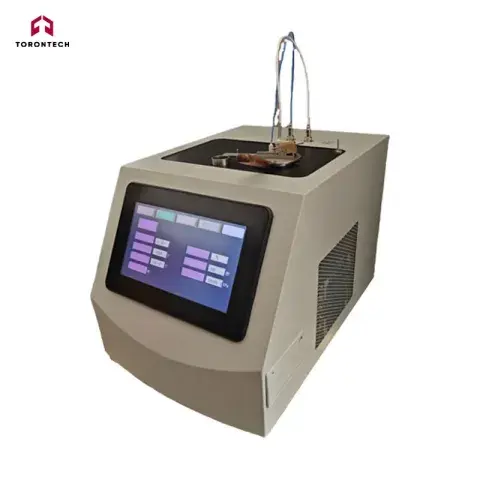Automatic Abel Closed Cup Flash Point Tester
Automatic Abel Closed Cup Flash Point Tester TT-170Z
TT-170Z Automatic Abel Closed Cup Flash Point Tester complies with IP170 and ISO 13736, which outline procedures for determining the flash point of petroleum products and other liquids using the Abel closed cup method.
This method is applicable to substances with flash points between -30°C and 70°C. However, the accuracy of the method is confirmed for flash points in the range of -5°C to 66.5°C. It's important to note that this standard does not apply to water-based paints, which can be tested using ISO 3679 instead.
The primary application of the TT-170Z Automatic Abel Closed Cup Flash Point Tester is to determine the flash point of highly volatile petroleum products and other liquids, in compliance with standards like ISO 13736 and IP 170. The test is specifically designed for materials with low flash points, typically in the range of -30°C to 70°C. It is a critical safety test used to classify materials as flammable for shipping and handling regulations.
Key Industries
- Chemical Manufacturing: This is a key industry for the Abel method. It is widely used for testing highly volatile solvents, alcohols, esters, and other chemical products to ensure they are correctly classified and labeled for safe transport and use.
- Paints, Inks & Coatings: Manufacturers in this sector use the Abel tester to determine the flash point of their solvent-based products. This is a mandatory test for regulatory compliance, as the flash point dictates the safety precautions required for storage, transportation, and application.
- Petroleum Refining: Refineries use this instrument to test the flash point of very light and volatile petroleum fractions and specialty products, such as jet fuels and certain solvents, that fall within the low temperature range of the Abel method.
- Control System: The instrument features bilingual menus, with a full-color, intuitive GUI touch screen interface for easy operation. The system is designed for efficiency with a reasonable structure, rapid test speed, a wide testing range, and excellent repeatability and accuracy. The entire testing process is automated, displaying parameters such as temperature and time on the LCD screen. Users can also monitor the working status and receive operation prompts directly on the display. Once the desired flash point or starting temperature is preset, the instrument will automatically cool or heat at the required rate, performing ignition, flash point detection, air cooling, and printing of results. It also adjusts the results to account for atmospheric pressure changes and can store up to 1,000 test records for future review and printing. Preset parameters are retained even after shutdown.
- Dual Ignition Modes: The instrument supports both electronic and gas ignition, allowing the operator to select the method based on specific needs. Both methods perform equally well.
- Modular Independent Design: The cup lid assembly, flash point sensor, and temperature sensor are all independently designed, making it easier to replace individual components as needed.
- Self-Check and Diagnostics: Upon startup, the instrument automatically checks the flash point sensor, Pt100 oil temperature sensor, electronic igniter, thermofuse, and other components. It also performs a self-check on the ignition system, stirring arm, and cooling and heating systems. If a fault is detected or if any connection is abnormal, the instrument will beep and display an error message such as “××× abnormal, please check connection.”
| Test temperature range | -30~80℃ |
| Temperature detection | Platinum resistor, Pt100 |
| Display mode | 7-inch LCD |
| Cooling mode | Compressor (connect external circulating water bath) |
| Heating rate | 1℃/min, Temperature Resolution: 0.1℃ |
| Stirring speed | 0.5r/s (30rpm) |
| Ignition mode | Electric or gas |
| Ambient requirements | 10~40℃, Relative humidity ≤85% |
| Power consumption | ≤450W |
| Low temperature circulating bath | ≤1000W |


